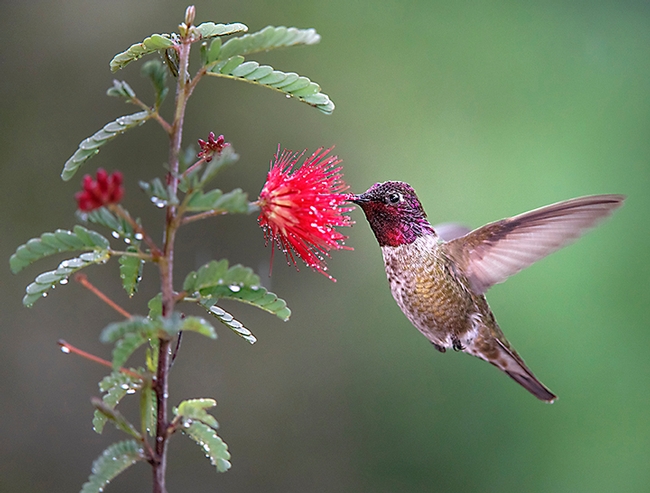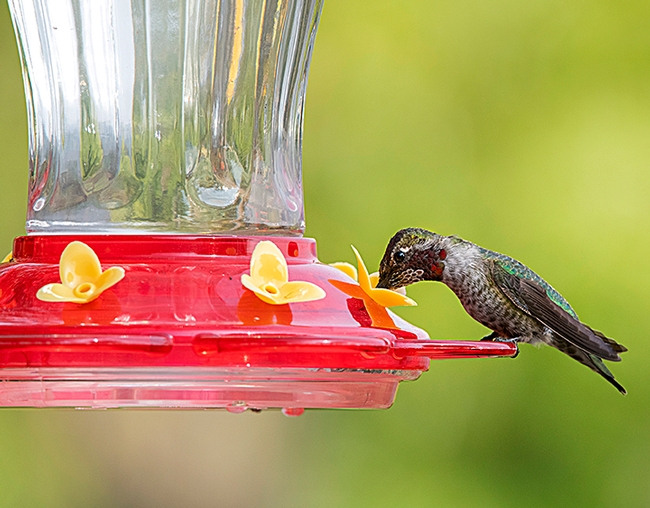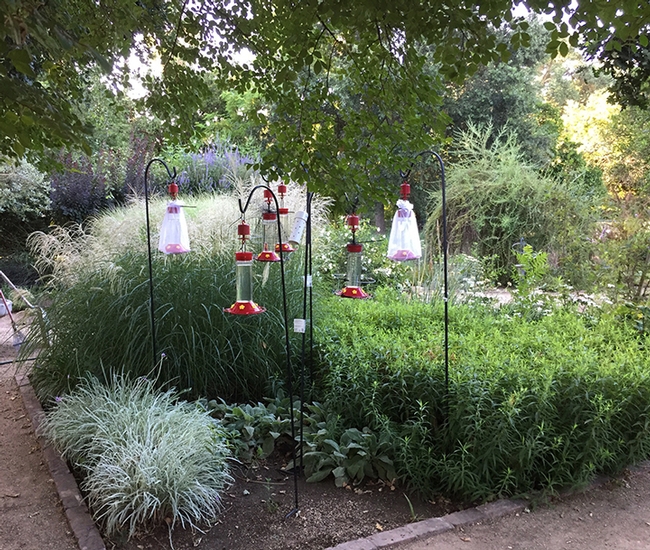- Author: Kathy Keatley Garvey
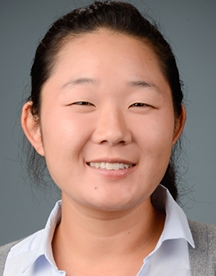

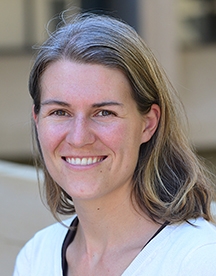
DAVIS--If you're like many Americans, you've set up a hummingbird feeder in your yard to nurture and watch these high-energy pollinators. But are you concerned that the sugar water you provide might be impacting your tiny feathered friends?
Newly published research indicates that sugar water in hummingbird feeders can contain high densities of microbial cells but “very few of the bacteria or fungi identified have been reported to be associated with avian disease,” says community ecologist and co-author Rachel Vannette of the University of California, Davis.
The research, published in the Proceedings of the Royal Society B, is one of the first to explore the microbial communities that dwell in sugar water from feeders and compare them to those found in flower nectar and samples from live hummingbirds.
“The potential for sugar water from hummingbird feeders to act as a vector for avian pathogens--or even zoonotic pathogens--is unknown,” said Vannette, an assistant professor in the UC Davis Department of Entomology and Nematology. “Our study is one of the first to address this public concern. Although we found high densities of both bacteria and fungi in sugar water samples from feeders, very few of the species of bacteria or fungi found have been reported to cause disease in hummingbirds.”
“So although birds definitely vector bacteria and fungi to feeders, based on the results from this study, the majority of microbes growing in feeders do not likely pose significant health hazards to birds or humans,” Vannette said. “However, a tiny fraction of those microbes has been associated with disease, so we encourage everyone who provides feeders for hummingbirds to clean their feeders on a regular basis and to avoid cleaning feeders in areas where human food is prepared.”
The paper, “Microbial Communities in Hummingbird Feeders Are Distinct from Floral Nectar and Influenced by Bird Visitation,” is the work of first author Casie Lee, a UC Davis School of Veterinary Medicine student; Professor Lee Tell of the UC Davis School of Veterinary Medicine's Department of Medicine and Epidemiology; Tiffany Hilfer, an undergraduate student and Global Disease Biology major; and Vannette.
Lee, mentored by Vannette and Tell, led the field experiment and performed bird observations and laboratory work during a summer project funded by the Students Training in Advanced Research (STAR) and Merial Veterinary Scholars Programs.
The researchers also compared the microbes in the feeders to those in floral nectar and found they differed in microbial composition.
“Birds, feeder sugar water, and flowers hosted distinct bacterial and fungal communities,” they wrote in their abstract. “Floral nectar and feeder sugar water hosted remarkably different bacterial communities; Proteobacteria comprised over 80% of nectar bacteria, but feeder sugar water contained relatively high abundance of Firmicutes and Actinobacteria, as well as Proteobacteria. Hummingbird feces hosted both bacterial taxa commonly found in other bird taxa and novel genera including Zymobacter (Proteobacteria) and Ascomycete fungi.”
The UC Davis scientists conducted their research at a private residence in Winters, attracting two hummingbird species, Calypte anna (Anna's Hummingbird) and Archilochus alexandri (Black-chinned Hummingbird) to drop net feeder traps. They mixed bottled water with conventional white granulated sugar (one part sugar and four parts water).
The researchers assigned feeders to one of three treatments including (1) access by both hummingbirds and insects (open feeders), (2) restricted access by birds but access by insects allowed (caged feeders, 1.5 cm square mesh), or (3) restricted access by both birds and insects (feeders bagged using gallon paint strainer bags), with two replicates of each treatment set up at each site, and the setup was replicated four times throughout the summer.
They examined and characterized microbial communities on bills and fecal material of the two species, as well their food resources, the feeder sugar water, and floral nectar. They tested sugar water from feeders that were visited and not visited. Results indicated that “both accumulated abundant microbial populations that changed solution pH and bird visitation rates.” Although both feeder sugar water and flowers contained aerobic, sugar-loving bacteria, they found that floral nectar contained mostly bacteria found only in flowers (Acinetobacter and Rosenbergiella) while feeder sugar water contained generalist bacteria that grow in many types of aqueous environments.
In pointing out that the microbial populations in the feeders differed from those in natural floral nectar, the UC Davis scientists noted that “human provisioning (of sugar water in feeders) influences microbial intake by free-ranging hummingbirds; however, it is unknown how these changes impact hummingbird gastrointestinal flora or health.”
As part of the study, they also performed a small experiment to assess how water type influences microbial growth. When feeders were exposed to birds, they found that deionized water supports the most fungal growth while tap water or bottled water supports the most bacterial growth.
“The microbes that hummingbirds are eating depends a lot on bird diet-- if they have access to feeders or are just consuming floral nectar,” Vannette said. “We don't know what the consequences are for bird health or gastrointestinal flora but we think that there should be more studies examining this, as many, many people use feeders, and the birds are opportunistic and drink from feeders!”
Hummingbirds (family Trochilidae) are one of the world's few avian pollinators. “Nearly 15% of hummingbird species are threatened or endangered,” the scientists related, so “understanding drivers of health and population dynamics may help conservation efforts. Avian microbial associates are just beginning to be studied in depth.”
Professor Tell said that “although our study does not directly inform hummingbird health outcomes, shifts in microbial composition in bird diets may influence bird microbiomes as a consequence. In the future, it will be important to understand how consumed microbial populations could potentially influence the health of free ranging hummingbirds, particularly with regards to anthropogenic effects on wildlife.”
Tell emphasized that the ideal human-provisioned food source for hummingbirds is floral nectar. “However, if feeders are offered, best practices entail routine and thorough cleaning that does not result in harmful residues,” she said.
Lee, who previously worked in wildlife rehabilitation and studied ecology before enrolling in the UC Davis School of Veterinary Medicine, commented: “I was very excited to work on a project that examined health of backyard wildlife in the context of modern society and grateful to have done it in the company of such hummingbird enthusiasts.”
Vannette was recently named one of 11 campus recipients of Hellman Fellowship grants, awarded to assistant professors who exhibit potential for great distinction in their research. Her project, “Characterizing the Structure and Function of Pollinator Microbiomes,” involves investigating the communities of bacteria and fungi in flowers and pollinators, including bees and hummingbirds. “Our work to date suggests that microbes in flowers are common and influence pollinator behavior,” she said.
